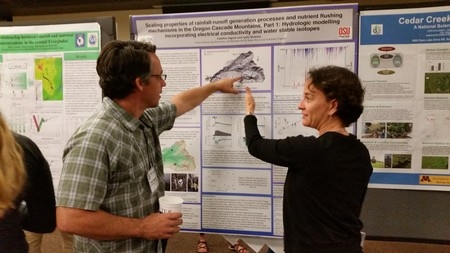Models and Software
During the course of our research various models and software have been developed. These include programs (software) to process and display specific data as well as simulation models. Documentation and, in some cases, downloadable files for these products are available here.
Models
- CASCADE:
- Generate landscape pattern dynamics in response to forest cutting and subsequent regrowth.
- Citation:
- Wallin, D.O., F.J. Swanson, B. Marks, J. Kertis and J. Cissel. 1996. Comparison of managed and pre-settlement landscape dynamics in forests of the Pacific Northwest, U.S.A.. Forest Ecology and Management 85:291-309. (Pub No: 2198).
- Wallin, D.O., F.J. Swanson and B. Marks. 1994. Landscape pattern response to changes in the pattern-generation rules: land-use legacies in forestry. Ecological Applications 4(3):569-580 (Pub No: 1579).
- HARVEST:
- Estimates the amount of woody slash remaining after timber harvest.
- Citation:
- Harmon, M. E.; Garman, S. L.; Ferrell, W. K. 1996. Modeling historical patterns of tree utilization in the Pacific Northwest: carbon sequestration implications. Ecological Applications 6(2):641-652 (Pub No: 1444).
- LANDMOD:
- Simulates vegetative dynamics, forest management, and natural disturbances at a landscape scale
- Citation:
- Garman, S. L. 2004. Design and evaluation of a forest landscape change model for western Oregon. Ecological Modelling 175(4):319-337 (Pub No: 3780).
- Nitrogen Fixation Rates in Dead Wood:
- A mechanistic simulation model of nitrogen fixation in dead wood to synthesize current knowledge, develop hypotheses, and estimate nitrogen fixation rates in the Pacific Northwest.
- Citation:
- William T. Hicks, Mark E. Harmon, and Steven L. Garman (2000). Modeling Nitrogen Fixation Rates in Dead Wood. Chapter 5 from Hicks, William T. 2000. Modeling nitrogen fixation in dead wood. Corvallis, OR: Oregon State University. 160 p. Ph.D. dissertation (Pub No: 212).
- PRISM:
- Spatially interpolates precipitation based on topography and observed precipitation. Western States precipitation maps are available from the Oregon Climate Service.
- Citation:
- Daly, C., R.P. Neilson, and D.L. Phillips. 1994. A statistical-topographic model for mapping climatological precipitation over mountainous terrain. Journal of Applied Meteorology 33: 140-158 (Pub No: 4955).
- STANDCARB:
- A model to simulate the accumulation of carbon over succession in mixed species, mixed aged forest stands.
- Citation:
- Mark E. Harmon, Barbara Marks and Narayana Rao Hejeebu (1996). A Users Guide to STANDCARB version 1.0: A model to simulate the carbon stores in forest stands (Pub No: 2248).
- STANDCARB2:
- A model to simulate the accumulation of carbon over succession in mixed species, mixed aged forest stands.
- Citation:
- Harmon, M. E. and J. B. Domingo. 2001. A Users Guide to STANDCARB version 2.0: A model to simulate the carbon stores in forest stands (Pub No: 2817).
- STREAM ECOSYSTEM MODEL:
- Simulates temporal trajectories of ecological processes in stream ecosystems.
- Citation:
- McIntire, C. David; Gregory, Stanley V.; Steinman, Alan D.; Lamberti, Gary A. 1996. Modeling benthic algal communities: an example from stream ecology. In: Stevenson, R. J.; Bothwell, M.; Lowe, R. L., eds. Benthic algal ecology in freshwater ecosystems (Algal Ecology). Academic Press, Inc.: 669-704 (Pub No: 1528).
- McIntire, C. David. 1990. A tutorial and teaching guide for the use of a lotic ecosystem model. Corvallis, OR: Oregon State University, Department of Botany and Plant Pathology. 271 p. (Pub No: 4362).
- McIntire, C. David; Colby, Jonathon A. 1978. A hierarchical model of lotic ecosystems. Ecological Monographs. 48:(1) 167-190 (Pub No: 1910).
- STREAMWOOD:
- Release Version 12-21-2001.
- Citation:
- Meleason, Mark A. 2001. A simulation model of wood dynamics in Pacific Northwest streams. PhD. Dissertation, Oregon State University. 158 pp (Pub No: 2871).
Software
- ANRAD:
- Estimates potential direct and diffuse radiation at 120 meter resolution grid for target days of interest.
- Citation:
- Greenland, David 1996. Potential Solar Radiation at the H. J. Andrews Experimental Forest. Interim Report PNW 93-0477. Portland, OR: U.S. Department of Agriculture, Forest Service, Pacific Northwest Research Station. 39 p (Pub No: 2240).
- BIOPAK:
- Calculates the biomass, area, height, length, or volume of plant components (leaves, branches, stem, crown, and roots) using existing prediction equations.
- Citation:
- Means, Joseph E., Heather A. Hansen, Greg J. Koerper, Paul B. Alaback, Mark W. Klopsch. 1994. Software for computing plant biomass--BIOPAK users guide. Gen. Tech. Rep. PNW-GTR-340. Portland, OR: U.S. Department of Agriculture, Forest Service, Pacific Northwest Research Station. 184 p (Pub No: 1659).
- Offers a comprehensive choice of landscape metrics to quantify landscape structure. Separate versions exist for vector and raster images.
- Citation:
- McGarigal, Kevin; Marks, Barbara J. 1995. FRAGSTATS: spatial pattern analysis program for quantifying landscape structure. Gen. Tech. Rep. PNW-GTR-351. Portland, OR: U.S. Department of Agriculture, Forest Service, Pacific Northwest Research Station. 122 p (Pub No: 1538).
- SOLARRAD:
- Estimates the solar radiation input to a site based on its latitude, elevation, aspect, slope, and cloud cover.
- Citation:
- Harmon, Mark E.; Marks, Barbara J. 1995. Programs to Estimate the Solar Radiation for Ecosystem Models. Department of Forest Science, Oregon State University. Internal web report. 15p (Pub No: 4979).
- XSPRO:
- Analyzes stream channel cross-section data including stage-to-discharge relationships and changes in channel cross-sectional area.
- Citation:
- Version 3: Hardy, Thomas; Palavi Panja; and Dean Mathias. 2005. WinXSPRO, A Channel Cross Section Analyzer, User's Manual, Version 3.0. Gen. Tech. Rep. RMRS-GTR-147. Fort Collins, CO: U.S. Department of Agriculture, Forest Service, Rocky Mountain Research Station. 95 p (Pub No: 4993).
- Version 2: USDA Forest Service, 1998. WinXSPRO, A Channel Cross-Section Analyzer, User’s Manual. USDA Forest Service, Rocky Mountain Research Station, Fort Collins, CO, unpublished manuscript.
- Version 1: Grant, Gordon E.; Duval, Joseph E.; Koerper, Greg J.; Fogg, James L. 1992. XSPRO: a channel cross-section analyzer. Tech. Note 387. Denver, CO: U.S. Dept. of the Interior, Bureau of Land Management and U.S. Dept. Agriculture, Forest Service. 53 p (Pub No: 1418).

